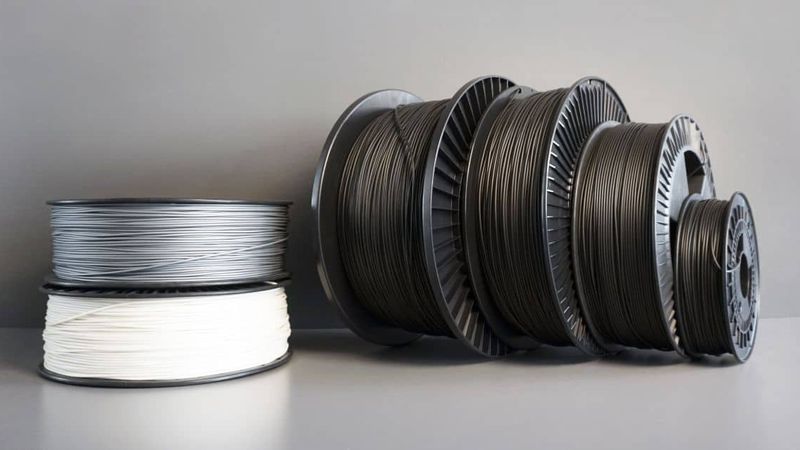PLA vs. ABS and More - Choosing the Right Filament
PLA and ABS are the most commonly used filaments out there. But which one should you pick? And are there other filament options for your application?

Which filament is best for your application?
This article was first published on
bigrep.comThe power of 3D printing is the ability to produce impossible designs that lead to enhanced functionality and performance. While it’s important to evaluate different technologies and processes, never underestimate material selection and capabilities.
With so many different 3D printing options in the marketplace and countless material options available, what makes the most sense for you? In this post we will compare several FDM materials and how these thermoplastics can be augmented to service a wider range of manufacturing applications. PLA vs. ABS, ASA, PLX, PRO HT, HI-TEMP, Carbon Fiber, Bio-ABS, and more.
ABS Filament
The most commonly used 3D printed material is ABS (Acrylonitrile Butadiene Styrene). ABS variations are used in every industry imaginable (transportation, consumer products, electronics, etc.). For example, plastic components make up 50 percent of a vehicle’s volume, but only about 10 percent of its weight. Therefore, prototypers, product developers, and production engineers feel comfortable printing materials that mimic the end-use product or purpose. Printing with ABS is an acceptable and easy solution for many manufacturers.
- Excellent mechanical strength and durability properties
- Cost effective & recyclable
- Better heat performance compared to PLA
- Great for 3D printing prototypes that require multiple iterations or low volume production requests

PLA Filament & PLX
Second only to ABS, PLA (Polylactic Acid) is a highly preferred 3D printing material because it is inexpensive, easy to use, and accessible on many platforms. Compared to ABS, PLA has slightly better tensile strength properties but generally doesn’t have enough flex strength. Both materials are comparable when it comes to pricing. However, under the right conditions, PLA is biodegradable and oftentimes used for food and packaging products making it rather attractive for many consumer product industries. In many instances, PLA is the preferred material choice. PLX, a PLA derivative, was recently introduced by BigRep and available on all platforms. PLX prints up to 80% faster and produces excellent surface features, eliminating the need for post processing.
- Biodegradable
- Up to 80% faster extrusion throughput
- Tensile strength (ISO 527) | 48 MPa
- Key industries: Consumer products, food packaging, prototyping, form, fit, and function


ASA Filament
ASA (Acrylonitrile Styrene Acrylate) is an ABS alternative material with improved weather resistance properties that make it ideal for many outdoor applications. Compared to ABS, ASA has better mechanical properties, superior aesthetics, and it’s UV resistant. Printing with ASA is advantageous for industrial and end-use parts, oftentimes used for automotive, sporting goods, and consumer appliances. The downside is that ASA is slightly more expensive than ABS and produces toxic smoke when burned. Many UAV (unmanned aerial vehicle) developers will prototype with ASA material and even consider using it in the final product due to its UV stability and weather resistance.
- Enhanced UV stability
- Ideal for outdoor applications
- Improved aesthetics compared to ABS and PLA
- Key industries: Consumer products, defense applications, automotive, and aviation

PRO HT: High Temperature Filament
PRO HT, BigRep’s flagship material, is the most popular filament amongst BigRep customers and users. With a softening resistance up to 115 °C, it has significant increase in temperature resistance compared to the average PLA, making it ideal for practical, end-use applications. In addition, PRO HT is FDA compliant for food safety and meets all requirements of EU Directives for food contact. Derived from organic compounds, PRO HT is biodegradable under the correct conditions and has a much lower ecological impact than other plastics derived from fossil fuels. Most common applications include consumer products, packaging, general prototyping, manufacturing and low production tooling.
- Simple to print and easy post processing
- Low warping and shrinkage
- Biodegradable
- Heat resistance up to 115 °C

HI-TEMP CF: Carbon Fiber Filament
Carbon fiber materials are unique and fairly new to the 3D printing industry. Highly stiff and incredibly durable, HI-TEMP CF is heat resistant up to 115 °C and perfect for many tooling applications. For example, thermoforming, pattern and mold making will use HI-TEMP CF for class A surface finish and low moisture absorption.
Recommended reading: Carbon Fiber 3d Printing: How to 3D Print Strong Parts
Compared to many other thermoplastics, the carbon fiber attributes provide significant strength capabilities (>65 MPa) and is recommended as a superior alternative to ASA for functional prototyping or production. HI-TEMP CF is robust and resilient to withstand harsh manufacturing environments.
- Jigs, Fixtures, and Tooling
- Automotive prototyping and production
- Assembly line, manufacturing, and production
- Tensile strength (ISO 527) | 65 MPa

Conclusion
How to truly maximize the right filament for your application? When it comes to general prototyping, all of these materials can be considered and will most likely yield positive results for your product development. However, prototyping goes beyond just form, fit and function so we recommend taking a deeper dive into specific material characteristics to determine which makes the most sense for you. When it comes to production, it’s very important to consider the mechanical properties of your chosen material and how it will perform. Tooling or end-use products are required to meet certain standards and more often than not, sacrifices cannot be made.
To simplify, we recommend:
- PLA and ABS for simple prototype development.
- If you own BigRep 3D printer equipment, reach out to us to learn about PLX and the time savings it can provide.
- If you’re looking for UV stability or slightly better strength performance for prototyping or production, we recommend ASA.
- Finally, PRO HT and HI-TEMP CF are the most robust materials for low volume production, tooling or any other application that requires parts to perform in harsh environments.
Check out our wide range of 3D printing filaments and find the right material for your application.